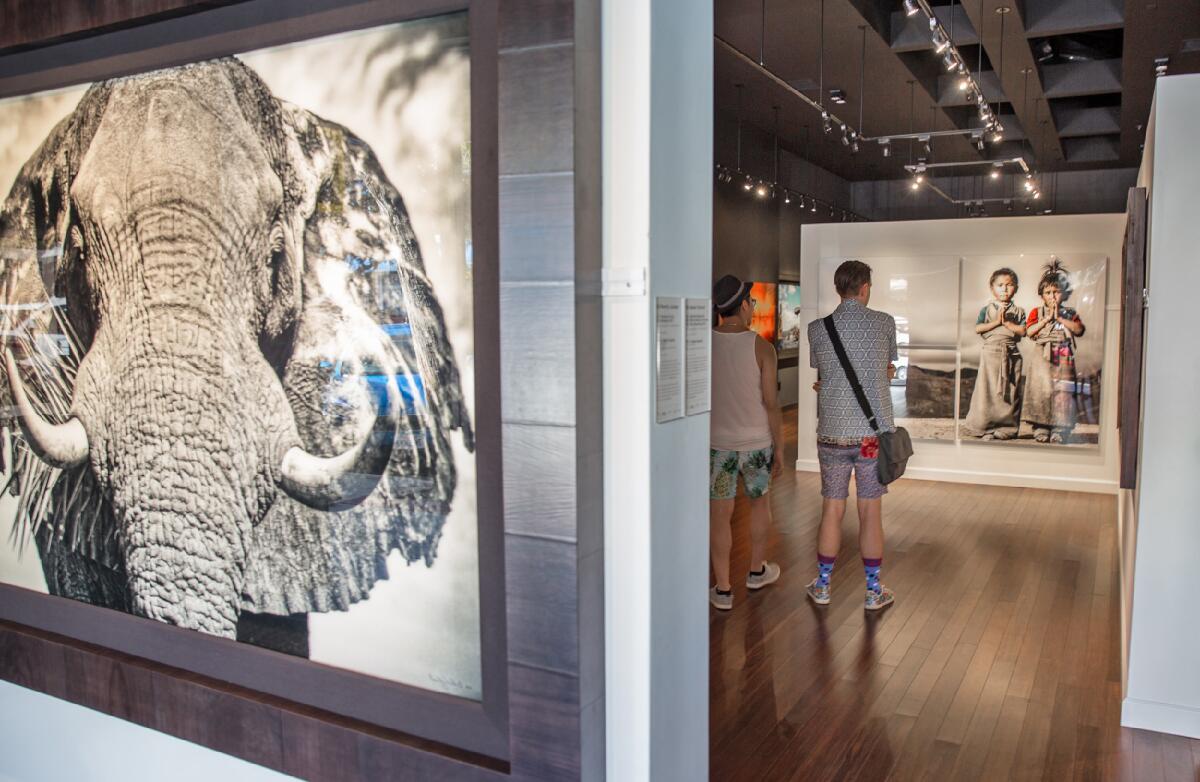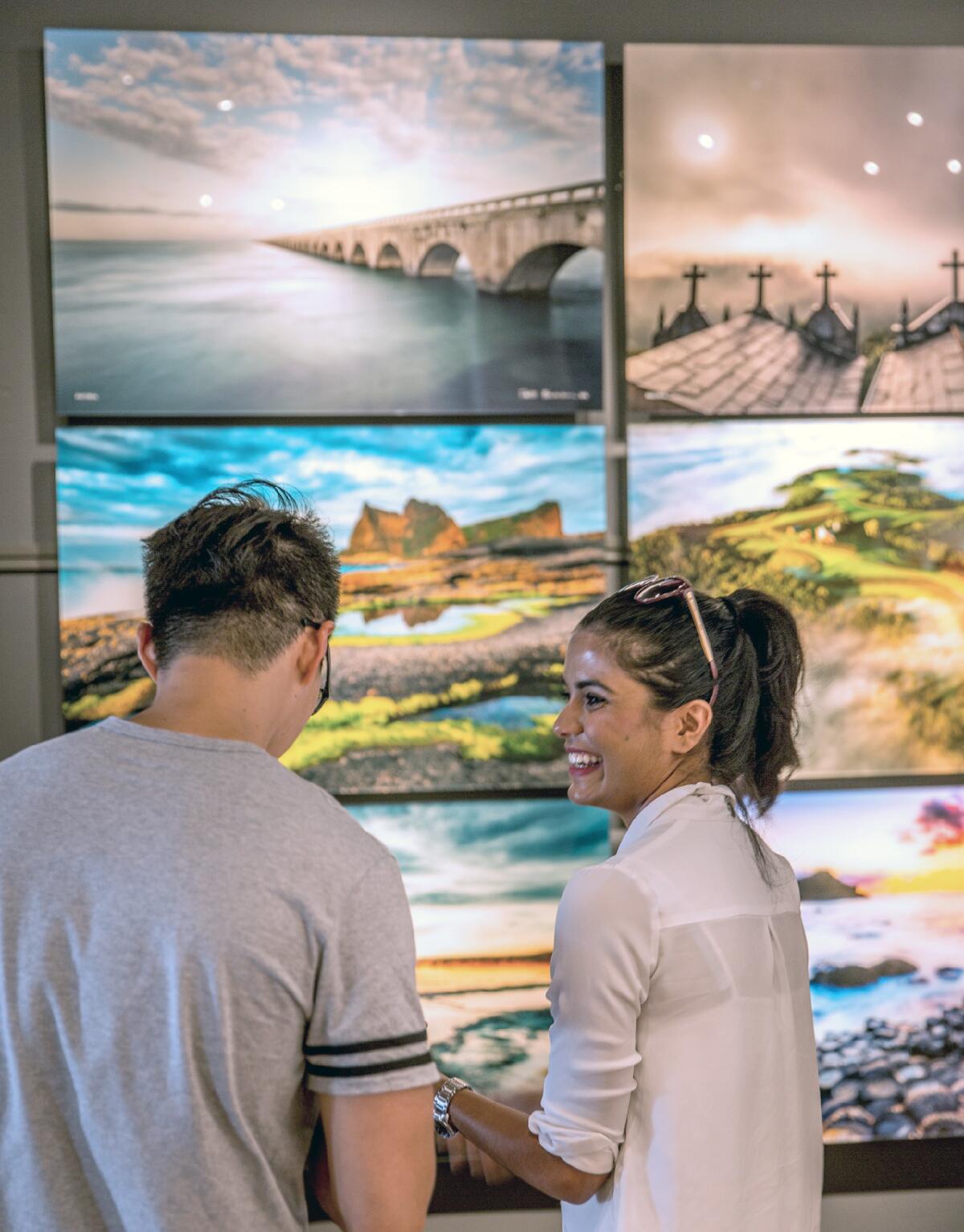Mesmerizing photos, and the stories behind them, turn content into art

- Share via
At a time when content is free, when compelling photography is a click away, National Geographic is still opening fine art galleries.
Why?
The answer is best felt.
It’s the feeling you get standing in front of an ancient African elephant. Or seeing a lion peering at you from behind billowing, yellow grass. Or seeing the weary eyes of a working child in a faraway country.
It’s the immediate immersion that is National Geographic, master of the breathtaking moment.
But it’s more than just beauty that differentiates the photos in National Geographic’s latest gallery at 218 Forest Ave., in Laguna Beach.
It’s the implicit story behind the shot. Modern photographers are sometimes criticized for using software as a crutch to accentuate their work. But when you are in front of a life-sized National Geographic photo, software is the last thing on your mind.
“National Geographic has very strict rules on the use of software,” said Gabrielle Immarino, the gallery’s director.
The results speak for themselves, 1,000 words at a time.
If you were to buy the custom, limited edition prints, which range from about $2,000 to $15,000, you get beautiful framing and the back story. You hear what it took to get the shot and why National Geographic stands out.
You learn, for example, that the amazing elephant was photographed by Beverly Joubert in the Okavango Delta, Botswana. Joubert has won numerous awards for photography, including eight Emmys and a Peabody.
“The Okavango Delta is a vast waterway with islands in between,” she wrote, describing the conditions for National Geographic. “We live in a tented camp. We cook on an open fire or on gas. We shower under the stars. We spend about 16 to 18 hours a day in our vehicle. Our vehicle becomes our home.”

Rozy Akther, right, of Irvine talks with friend Wayne Wei about the photos in the new National Geographic fine art gallery, at 218 Forest Ave. in Laguna Beach.
Most photographers at this level try to tell a bigger story, which is what visitor Rozy Akther appreciated during a recent visit to the gallery. Akther, from Irvine, is a budding photographer who was trying to learn some lessons from the photos.
“I like nature and man-made combined together,” she said, pointing to a simple picture of a bridge. “I like the ones that tell a story.”
Storytelling is embedded in multiple ways — the strength of the portrait, the impact of the expanse or the power of the action. With an emphasis on animals and nature, it’s hard not to find drama. But there are also a lot of urban photos.
For example, there’s a mesmerizing photo by Randy Olson called “Crowds at Churchgate Station” that was taken in India. It’s a time-lapsed photo that captures the crush of commuters and puts a spotlight on overpopulation.
Another dramatic people photo is of two young children in Nepal taken by Cory Richards. There is both an authenticity and vulnerability to the children, who are making the Namaste gesture.
“I wanted to make portraits of these incredible people who are more Tibetan than any Tibetan because there’s no Chinese influence,” Richards told the magazine. “I have a deep passion for their culture, and I try to use images to promote its preservation.”
While National Geographic is known for exposing exotic locations and cultures, there are also some captivating photos closer to home. In almost all cases, there is an Americana archetype: rural, dusty and in a way, nostalgic. The photos could have been shot 40 years ago.
The “General Store” in Lorman, Miss., was again taken by Olson, this time in 1995, but it has a timeless quality to it. There is a dapper African-American man standing casually outside of an old, weathered store. But there’s also a partial American flag waving prominently in the foreground. Together, there’s an ominous feel to it, as if our unavoidable race history impacts the picture.
These images and stories are what make fine art. It’s why there are galleries that can charge for content in an age when people expect everything for free.
And while local photographers often don’t have the luxury of storefronts, they too appreciate something like National Geographic because it helps raise the bar.
“I think it’s a good thing because it shows people what quality photography really is,” said Cliff Wassmann, an award-winning photographer who owns a gallery on Ocean Avenue. “A lot of people are not educated about art in general and especially photography.
“So I think it’s important for people to see quality like that so then when they leave that gallery and maybe go to the Sawdust Festival or somewhere, they have something to compare. And hopefully some of us will compare favorably to what they saw in there.”
Chances are there are favorable comparisons because Laguna is filled with stories.
Stories that just need to be captured and released.
For more information visit, natgeofineart.com.
---
DAVID HANSEN is a writer and Laguna Beach resident. He can be reached at [email protected].